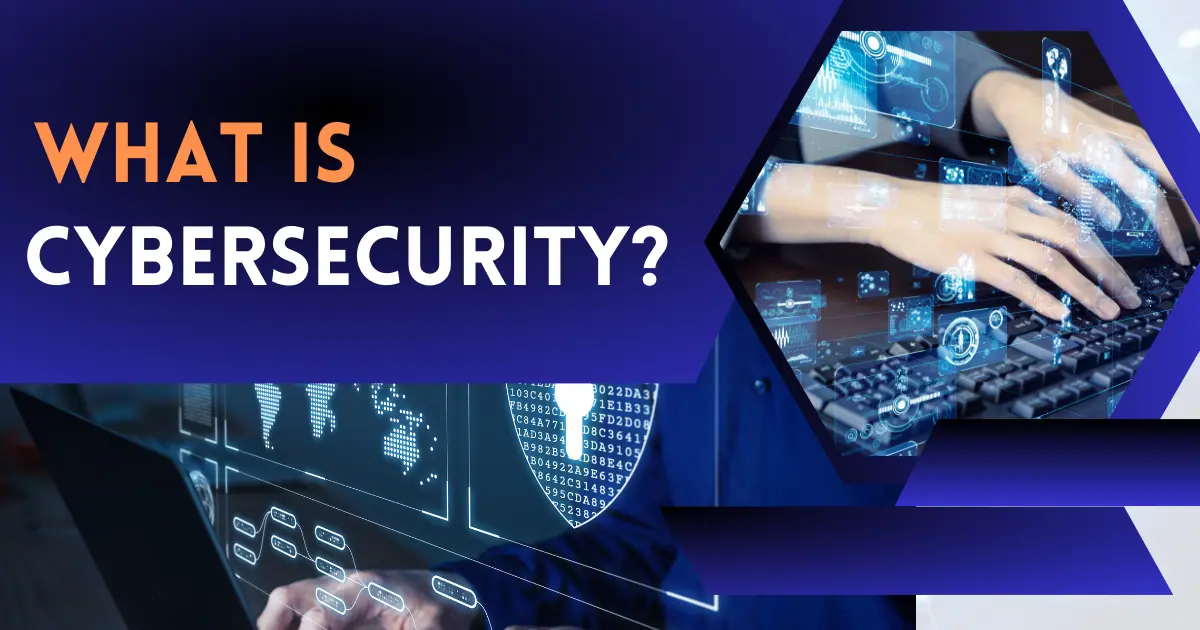Introduction:
The importance of cybersecurity cannot be stressed enough in today’s digital age, where technology has become a vital part of our lives. The risk of cyberattacks has increased dramatically due to the rapid proliferation of the internet and networked gadgets. This beginner’s book seeks to provide a complete overview of cybersecurity, including its significance, prevalent risks, job opportunities, and practical recommendations for anyone considering a career in this sector. Cybersecurity and ethical hacking are intertwined disciplines. Ethical hacking tests systems for vulnerabilities, aiding cybersecurity by identifying weaknesses and ensuring robust protection against cyber threats.
What is Cybersecurity?
Cybersecurity is the process of preventing unwanted access, attacks, or damage to computer systems, networks, and digital data. In an increasingly linked world where information is shared electronically on an unprecedented scale, cybersecurity is crucial to protecting sensitive data, ensuring the integrity of digital assets, and ensuring the availability of critical resources.
The term “cybersecurity” refers to a wide range of procedures and methods aimed at fighting against a variety of dangers, such as harmful software (malware), hacking attempts, data breaches, and so on. It entails putting in place strong security policies, encrypting data, and using innovative technology to monitor, detect, and respond to potential breaches.
CIA Triad: Confidentiality, Integrity, and Availability

The CIA Triad is a key cybersecurity concept that encompasses three core principles: confidentiality, integrity, and availability. These principles serve as the foundation for developing and executing effective digital security solutions.
1. Confidentiality
The need to secure sensitive information from unwanted access is emphasized by confidentiality. It ensures that certain data is only accessible to authorized individuals or institutions, preventing unauthorized disclosure or exposure. This idea is critical to preventing personal information, financial records, trade secrets, and other sensitive information from slipping into the wrong hands.
2. Integrity
The goal of integrity is to keep data accurate and trustworthy. It entails preventing unauthorized information modification, alteration, or tampering. Organizations may rely on the correctness of their records and systems by maintaining data integrity, avoiding the potential implications of erroneous or manipulated data.
3. Availability
The need for continuous access to data and systems is emphasized by availability. It entails putting in place safeguards to prevent disruptions, downtime, or denial-of-service assaults that could leave critical resources inaccessible. This principle is especially important for vital infrastructure, internet services, and communication networks that must run consistently.
Specialties in Cybersecurity:
The topic of cybersecurity includes several specialties, each focused on a different aspect of protection and defense. Among these specialties are:
1. Network Security:
The emphasis is on safeguarding communication channels and data delivery.
2. Application Security:
It entails protecting software programs against vulnerabilities.
3. Information Security:
Ensures that sensitive data is protected from unwanted access.
4. Incident Response:
Manages and mitigates the consequences of cyberattacks.
5. Ethical Hacking:
It entails simulating cyberattacks to identify vulnerabilities.
6. Cryptocurrency Security:
Dedicated to the security of digital assets and cryptocurrency transactions.
Basic Terminologies:
Understanding basic terminologies is critical for recognizing the key principles and practices that support digital security in the realm of cybersecurity. Some fundamental words are as follows:
1. Firewall:
A security barrier that monitors and controls incoming and outgoing network traffic, acting as a shield between a trusted internal network and outside sources.
2. Encryption:
To prevent unwanted access, data is converted into a code or cipher, ensuring that only authorized persons with the decryption key may comprehend the information.
3. Malware:
Malicious software, often known as malware, refers to any software that is meant to harm, exploit, or penetrate computer systems, such as viruses, worms, Trojans, and ransomware.
4. Phishing:
A deceitful tactic in which cybercriminals send phony emails, messages, or webpages to fool consumers into disclosing personal information such as passwords or credit card information.
5. Ransomware:
A form of malware that encrypts a victim’s data and demands a ransom for its release, causing substantial disruption and financial loss in the process.
Two-Factor Authentication (2FA):
A security mechanism that requires users to provide two forms of verification before accessing an account, providing an additional layer of protection in addition to a password.
1. Vulnerability:
A vulnerability or flaw in the design, implementation, or configuration of a system that attackers could exploit to obtain unauthorized access or compromise the system’s security.
2. Patch:
A software update that addresses vulnerabilities or defects in a program, operating system, or application, thereby increasing security and functionality,
3. Intrusion Detection System (IDS):
An application that monitors network traffic and system activities in order to detect and respond to unwanted or malicious activity.
4. Social Engineering:
Psychological manipulation techniques are used by cybercriminals to trick people into disclosing personal information or acting in ways that undermine security.
5. Zero-Day Exploit:
An assault that takes advantage of a previously unknown vulnerability, typically before software developers have had a chance to provide a remedy or patch.
Cyber Threat Intelligence:

Data on potential and ongoing cyber threats is collected and analyzed in order to guide proactive cybersecurity measures and incident response.
Understanding the fundamental principles of cybersecurity lays the groundwork for navigating the complex environment of digital security, allowing individuals and businesses to better protect themselves against developing cyber threats.
Common Types of Attacks
Knowing the most common cyber dangers is essential for effective defense. Some examples of common cyberattacks are:
1. Malware:
Viruses, worms, and Trojans are examples of software designed to harm or exploit computers.
2. Phishing:
Attempts to obtain sensitive information through deceptive communication
3. Ransomware:
Ransomware is malicious software that encrypts data and then demands cash to decrypt it.
4. Denial of Service (DoS) Attack:
Overwhelming a system to the point where it is unavailable to users
5. Social Engineering:
Social Engineering is the manipulation of individuals in order to obtain confidential information or perform actions.
How Can We Be Affected by Cybersecurity?
Cybersecurity breaches can harm anyone, from individuals to organizations and governments. Personal information may be stolen, financial accounts may be compromised, and secret information may be revealed. Organizations may suffer financial losses, reputational harm, and legal ramifications. Governments may face espionage, data theft, and interruptions of infrastructure. As a result, the significance of cybersecurity extends to all levels of society.
How to Become a Cybersecurity Analyst
To become a cybersecurity analyst, you must have a combination of education, skills, and experience. To enter this field, follow these steps:
1. Education:
Study computer science, cybersecurity, or a related field.
2. Skills Development:
Develop your knowledge of networking, programming, risk assessment, and security technologies.
3. Certifications:
CompTIA Security+, Certified Information Systems Security Professional (CISSP), or Certified Ethical Hacker (CEH) are examples of related certifications.
4. Experience:
Internships, projects, and entry-level work can help you get practical experience.
5. Continuous Learning:
Keep up-to-date on the changing threat landscape and emerging technology.
6. Cybersecurity in the Air Force:
The Air Force plays an important role in cybersecurity, securing both military assets and sensitive information. It engages professionals to guard against cyber threats, conduct penetration testing, and maintain crucial system security.
Risk Assessment in Cybersecurity:
Identifying potential risks, vulnerabilities, and repercussions on systems and data is part of risk assessment. It aids in the prioritization of security measures and the optimal allocation of resources to mitigate risks.
Requirements for a Career in Cybersecurity:
A strong background in computer science or a related subject, technical skills, problem-solving talents, and a desire to stay current with the ever-changing threat landscape is required for a career in cybersecurity.
Conclusion:
As technology advances, the value of cybersecurity grows rapidly. To create a secure and resilient digital environment, it is critical to safeguard digital assets, whether personal, organizational, or governmental. Individuals can contribute to a safer online world by knowing the fundamental ideas, risks, and practices of cybersecurity.
FAQs:
What is cybersecurity?
Cybersecurity is the process of safeguarding computer systems, networks, and data from unwanted access, attacks, or theft.
Why is cybersecurity important?
Cybersecurity safeguards digital assets by ensuring their confidentiality, integrity, and availability.
How can I learn cybersecurity?
Education, certificates, hands-on experience, and ongoing learning can all be used to master cybersecurity.
What are the best cybersecurity stocks?
The value of particular cybersecurity stocks might fluctuate over time. Look for current information from trusted sources.
How can I become a cybersecurity analyst?
Pursue relevant education, build technical skills, earn certifications, gain experience, and remain current on industry developments to become a cybersecurity analyst.
What is risk assessment in cybersecurity?
The process of evaluating potential risks and vulnerabilities in order to prioritize security measures and reduce potential threats is known as risk assessment.







